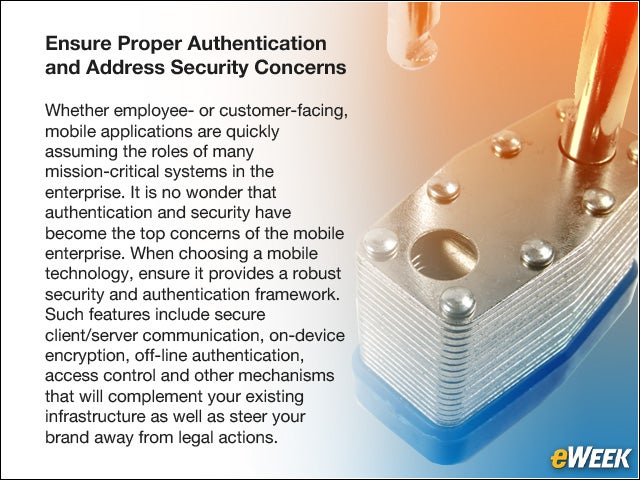eWEEK content and product recommendations are editorially independent. We may make money when you click on links to our partners. Learn More.
1Don’t Compromise on User Experience
Good apps are engaging. They are designed for performance and customized to deliver the functionality your users need in a simple and easy-to-use manner. However, achieving a seamless transition of code across multiple platforms, while maintaining an optimized user experience on each device, is easier said than done. When choosing a mobile application platform, be sure it can enable the development of apps that will address the unique requirements of your organization and your customers—both current and future.
2Support Different Development Approaches
Mobile apps are no longer an experiment. Companies are quickly realizing their value to different lines of business, both as productivity tools for employees and engagement channels facing customers. Choosing a development approach for these apps entails many parameters such as budget, project timeframe, target audience and application functionality. Finding the approach that best addresses the unique needs of each project can be a challenging task. The answer lies in a flexible solution, one that can harness the benefits that each provides and support the entire mobile strategy of the organization.
3Build for Performance
Recent reports show that already today, mobile users are spending more time using apps than mobile browsers. Combined with projections that more than 50 percent of users will access the Web through mobile devices by the end of 2013, application performance has never been more crucial for your mobile initiative. Among today’s mobile development solutions, one can find products that deliver hybrid development capabilities and allow developers to combine code within the same application. The hybrid technique results in a mobile application that delivers the experience users expect, but at the same time, includes code that can be shared across environments and is easily maintained and significantly cheaper to develop.
4Enable Collaboration, Efficiency
Modern business applications are constantly changing, and they are rarely developed by a single person anymore. In fact, one would normally find multiple teams working on different portions of the same app, from different geographic locations, and using different code languages, third-party libraries and open-source frameworks. In reality, it is becoming increasingly important to maintain a centralized overview of the process and ensure that the policies of the organization are enforced and maintained.
5Ensure Proper Authentication and Address Security Concerns
Whether employee- or customer-facing, mobile applications are quickly assuming the roles of many mission-critical systems in the enterprise. It is no wonder that authentication and security have become the top concerns of the mobile enterprise. When choosing a mobile technology, ensure it provides a robust security and authentication framework. Such features include secure client/server communication, on-device encryption, off-line authentication, access control and other mechanisms that will complement your existing infrastructure as well as steer your brand away from legal actions.
6Close the HTML5 Gap
Commitment from all major mobile vendors, active standardization efforts and a growing ecosystem of third-party tools has been fueling recent success and adoption of HTML5. Thanks to technological advancements in modern mobile browsers, using HTML5, today’s mobile developers can build cross-platform apps with cleaner code, an increase in distribution channels, advanced storage capabilities and access to more types of data. As HTML5 continues to evolve and cover more mobile features and functionality, early adopters will benefit from a seamless and gradual transition as opposed to an extreme overhaul of their entire mobile infrastructure.
7Connect With Back-End and Cloud-Based Systems
Mobile business apps are not independent entities. They should be tightly connected to a variety of existing back-end and cloud-based systems. Back-end integration determines not only the functionality of the app, but is also crucial for its performance, cost, scalability, time-to-market and regulatory compliance. The right solution will support the rapid integration of the company’s hybrid world of public clouds, private clouds and on-premises, back-end applications, as well as provide the mechanisms to orchestrate their integration.
8Manage Mobile Apps, Devices, Data
Managing applications after they are downloaded and installed on devices has become critical, with the bring-your-own-device (BYOD) trend specifically challenging IT departments. A growing number of organizations are starting to adopt a combination of management approaches, both on the application level and the device level. As mobile devices assume a more prominent role in customer engagements, organizations must prepare to collect and harness the data these transactions entail, analyze it and draw actionable conclusions. When choosing a platform, be sure such data is collected and can be easily exported to your existing business intelligence infrastructure.
9Evaluate Supporting Services
The mobile channel is transforming the way companies are doing business, and with that transformation, new challenges arise on both the business and the IT levels. At the business level, basic models are changing the way the business interacts and transacts with customers, employees and partners. At the IT level, development lifecycles have become more complicated; they must be faster and more iterative. Choosing a mobile platform that you can easily integrate into your existing IT infrastructure and leverage its resources where possible is only half the challenge. Be sure the vendor you are working with can support your mobile initiative with the experience and knowledge that will help extend and transform your business.
10Protect Your Investment
As the mobile landscape develops, success lies in the ability to adapt to change. To be successful, be aware that the mobile infrastructure that is at the core of your strategy must be able to support new environments as they reach the market and allow you to extend your capabilities to meet the needs of customers and employees.









